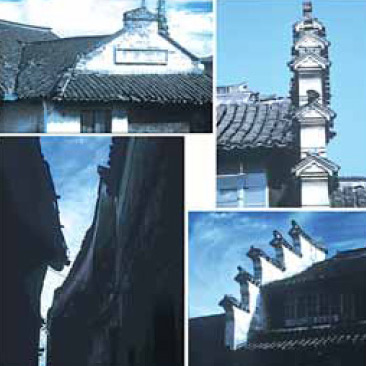Roots of Shanghai on show in region's resort
The Songjiang district takes a distinct pride in its reputation as the authentic root of old Shanghai. It has a history dating back to more than 2,000 years ago, when a section of the modern day city still formed part of the bed of the East China Sea.
|
|
|
The buildings in Songjiang's Old Street are said to be at least twice the age as the ones in Zhouzhuang in nearby Suzhou. |
It has been known for its booming industry and businesses since the time of the Ming Dynasty. It was once reputed to "provide clothing and bed sheets for the entire nation" as a result of its all-encompassing textile industry. It was as at least as prosperous as neighboring Suzhou, with the two economies "contributing more than half of the country's taxes".
Today Songjiang is a district in one of the most dynamic economic hubs in China. While the focus is frequently on the booming city center to its east, this venerable district has evolved into one of the most popular tourist sites in Shanghai.
Set some 30 km from the center of Shanghai, Songjiang combines cultural wealth with natural beauty and mixes ancient memories with modern thrills. These feelings are inevitably shared by any tourist spending a day or two in one of the following resorts:
Sheshan National Tourism Resort
Established in 1994, this 64 sq km resort is one of the 12 national-level holiday resorts in China. It is the only place in Shanghai that features both natural hills and forests.
The Sheshan National Forest Park is the major attraction in the area. Covering about 4 sq km, this park is famous for its dense bamboo forests. It was rated by the National Tourism Administration as a 4-A class tourism destination in 2000.
Although Shanghai is famously flat, due to its location in the Yangtze River Delta plain, Sheshan prides itself on its dozen or so hills - the largest reaching 99m above sea level, giving the area an undulating landscape that distinguishes it from the rest of the city.
Of the many sights available, East and West Sheshan have proved the most popular among tourists. At 74 m, the former features wide spread forests and bamboo camphor, whilst providing, on clear days, memorable views of the Pudong Oriental Pearl Tower, the Jinmao Tower and the Shanghai World Financial Center.
The adjacent West Sheshan area has accommodated a number of religions, including Buddhism, Taoism, Christianity and Catholicism throughout its long history. The Sheshan Cathedral, built some 85 years ago, was once the largest cathedral in the Far East. The Shanghai Astronomic Observatory and the Seismic Station are also located on the nearby hillside.
The resort now has two golf clubs and a car-racing track, offering a memorable experience for sports enthusiasts.
Songjiang Old Street
The buildings in Songjiang's Old Street are said to be at least twice the age and twice as beautiful as the ones in Zhouzhuang, in neighboring Suzhou.
Songjiang is also home to a number of well-preserved ancient relics. The oldest of these is the 9.3-m Toroni Sutra Stele, built during the Tang Dynasty (618AD-907) and now set in the grounds of a primary school in the Old Street.
There are also five ancient pagodas in Songjiang, with the most famous being the Square Pagoda, a nine-story, 42.5-m-high building, modeled after the style of a Buddhist pagoda from the Tang Dynasty. It was built during the Song Dynasty (960-1279) and is now situated in a park containing many somber, yet simple, buildings from that period.
|
|
|
The Square Pagoda is a Tang Dynasty styled Buddhist building. |
After its completion in 1909, the Songjiang Railway Station, an unmissable feature of the street, became a well-known example of "Western architecture with Chinese characteristics" and served as a frequently used backdrop for films, depicting the turbulent times of the 1930s and 1940s.
Songjiang New City
In 2001, the Shanghai municipal government began the implementation of a massive program to build satellite towns to re-house its 1 million or so people.
Among the satellite towns, only the large-scale Songjiang New City, located to the north of the Songjiang district, can be truly called a city. Showing a distinct influence of British architecture, it has been designed to accommodate 500,000 people in an area of some 60 sq km. It also has an aesthetic intended to appeal to both residents and visitors.
Inside the new city, there is the Songjiang University Town, covering 5.33 sq km and currently home to seven different universities.
The Thames Town is another stop that should be added to any travel itinerary in the area. The 1sq km community is an imitation of a traditional British town, complete with Georgian and Victorian style villas and apartments, all surrounded by lakes, rivers, bushes and trees.
Wushe Agricultural Leisure and Sightseeing Park
Located in the water source conservation zone in the upper reaches of the Huangpu River with an area of 11.19 sq km, this park has been designed as a showcase for the integration of agriculture and tourism. Its amenities include recreational farms where visitors can pick grapes or tomatoes. There is also an aquatic farm, a flower farm as well as a petting zoo.
Visitors can choose between picking fresh fruits and vegetables or enjoying a home cooked meal at one of the local farmer's residences. The park is also equipped with state-of-the-art meeting and entertainment facilities.
 0 Comments
0 Comments








